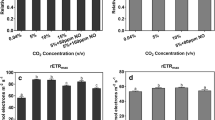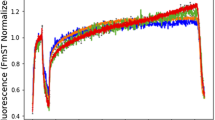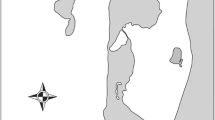Abstract
Modulated chlorophylla fluorescence is useful for eco-physiological studies of lichens as it is sensitive, non-invasive and specific to the photobiont. We assessed the validity of using fluorescence yield to predict CO2 gain in cyano-lichens, by simultaneous measurements of CO2 gas exchange and chlorophylla fluorescence in five species withNostoc-photobionts. For comparison, O2 evolution and fluorescence were measured in isolated cells ofNostoc, derived fromPeltigera canina (Nostoc PC). At irradiances up to the growth light level, predictions from fluorescence yield underestimated true photosynthesis, to various extents depending on species. This reflected the combined effect of a state transition in darkness, which was not fully relaxed until the growth light level was reached, and a phycobilin contribution to the minimum fluorescence yield (Fo). Above the growth light level, the model progressively overestimated assimilation, reflecting increased electron flow to oxygen under excess irradiance. In cyanobacteria, this flow maintains photosystem II centres open even up to photoinhibitory light levels without contributing to CO2 fixation. Despite this we show that gross CO2 gain may be predicted from fluorescence yield also in cyanolichens when the analysis is made near the acclimated growth light level. This level can be obtained even when measurements are performed in the field, since it coincides with a minimum in non-photochemical fluorescence quenching (NPQ). However, the absolute relation between fluorescence yield and gross CO2 gain varies between species. It may therefore be necessary to standardise the fluorescence prediction for each species with CO2 gas exchange.
Similar content being viewed by others
Abbreviations
- CCM:
-
CO2-Concentrating mechanism
- Chl:
-
chlorophyll
- Ci :
-
inorganic carbon
- 0:
-
convexity (curvature of the light response curve)
- ETR:
-
electron transport rate
- Fo :
-
minimum fluorescence yield
- Fm :
-
maximal fluorescence yield
- Fs :
-
fluorescence yield at steady-state photosynthesis
- Fv :
-
variable fluorescence yield
- Fv′/Fm′ dark:
-
ratio of variable to maximal fluorescence yield after dark adaptation
- FvFmmax:
-
ratio of variable to maximal fluorescence yield in the absence of quenching
- ΦCO2 :
-
maximum quantum yield of CO2 assimilation
- ΦPSμ :
-
quantum yield of photosystem II photochemistry
- GP:
-
gross photosynthesis
- I:
-
irradiance (μmol quanta·m−2·s−1)
- NPQ:
-
non photochemical fluorescence quenching
- qp:
-
photochemical fluorescence quenching
References
Badger MR, Price GD (1992) The CO2 concentrating mechanism in cyanobacteria and green algae. Physiol Plant 84: 606–615
Badger MR, Schreiber U (1993) Effects of inorganic carbon accumulation on photosynthetic oxygen reduction and cyclic electron flow in the cyanobacteriumSynechococcus PCC 7942. Photosynth Res 37: 177–191
Badger MR, Pfanz H, Büdel B, Heber U, Lange OL (1993) Evidence for the functioning of photosynthetic CO2-concentrating mechanisms in lichens containing green algal and cyanobacterial photobionts. Planta 191: 57–70
Bilger W, Björkman O (1990) Role of the xanthophyll cycle in photoprotection elucidated by measurements of light-induced absorbance changes, fluorescence and photosynthesis in leaves ofHedera canariensis. Photosynth Res 25: 173–186
Büchel C, Wilhelm C (1993) In vivo analysis of slow chlorophyll fluorescence induction kinetics in algae: progress, problems and perspectives. Photochem Photobiol 1: 137–148
Campbell D (1996) Complementary chromatic adaptation alters photosynthetic strategies in the cyanobacteriumCalothrix. Microbiology 142: 1255–1263
Campbell D, Öquist G (1996) Predicting light acclimation in cyanobacteria from non-photochemical quenching of PSII fluorescence, which reflects state transitions in these organisms. Plant Physiol 111: 1293–1298
Campbell D, Bruce D, Carpenter C, Gustafsson P, Öquist G (1996) Two forms of the photosystem II D1 protein alter energy dissipation and state transitions in the cyanobacteriumSynechococcus sp. PCC 7942. Photosynth Res 47: 131–144
Clarke AK, Hurry VM, Gustafsson P, Öquist G (1993) Two functionally distinct forms of the PS II reaction-centre protein D1 in the cyanobacteriumSynechococcus sp. PCC 7942. Proc Natl Acad Sci USA 90: 11985–11989
Demmig-Adams B, Adams WW, Czygan F-C, Schreiber U, Lange OL (1990) Differences in the capacity for radiationless energy dissipation in the photochemical apparatus of green and blue-green algal lichens associated with differences in carotenoid composition. Planta 180: 582–589
Dominy PJ, Williams WP (1987) The role of respiratory electron flow in the control of excitation energy distribution in blue-green algae. Biochim Biophys Acta 892: 264–274
Edwards GE, Baker NR (1993) Can CO2 assimilation in maize leaves be predicted accurately from chlorophyll fluorescence analysis? Photosynth Res 37: 89–102
Genty B, Briantais JM, Baker NR (1989) The relationship between the quantum yield of photosynthetic electron transport and quenching of chlorophyll fluorescence. Biochim Biophys Acta 990: 87–92
Hirano M, Satoh K, Katoh S (1980) Plastoquinone as a common link between photosynthesis and respiration in blue-green algae. Photosynth Res 1: 149–162
Hovenden MJ, Seppelt RD (1995) Utility of modulated fluorescence in measuring photosynthetic activity of antarctic plants, field and laboratory studies. Aust J Plant Physiol 22: 321–330
Krall JP, Edwards GE (1992) Relationship between photosystem II activity and CO2 fixation in leaves. Physiol Plant 86: 180–187
Lange OL, Bilger W, Rimke S, Schreiber U (1989) Chlorophyll fluorescence of lichens containing green and blue-green algae during hydration by water vapour uptake and by addition of liquid water. Bot Acta 102: 306–313
Leverenz JW, Jarvis PG (1979) Photosynthesis in Sitka spruce VIII. The effects of light flux density and the direction on the rate of net photosynthesis and the stomatal conductance of needles. J Appl Ecol 16: 919–932
Lüttge U, Büdel, Ball E, Strube F, Weber P (1995) Photosynthesis of terrestrial cyanobacteria under light and desiccation stress as expressed by chlorophyll fluorescence and gas exchange. J Exp Bot 46: 309–319
Miller AG, Canvin DT (1987) The quenching of chlorophylla fluorescence as a consequence of the transport of inorganic carbon by the cyanobacteriumSynechococcus UTEX 625. Biochim Biophys Acta 894: 407–413
Miller AG, Espie GS, Canvin DT (1991) The effects of inorganic carbon and oxygen on fluorescence in the cyanobacteriumSynechococcus UTEX 625. Can J Bot 69: 1151–1160
Mullineaux CW, Allen JF (1986) The state 2 transition in the cyanobacteriumSynechococcus 6301 can be driven by respiratory electron flow into the plastoquinone pool. FEBS Lett 205: 155–160
Palmqvist K, Sundblad LG, Wingsle G, Samuelsson G (1990) Acclimation of photosynthetic light reactions during induction of inorganic carbon accumulation in the green algaChlamydomonas reinhardtii. Plant Physiol 94: 357–366
Palmqvist K, Samuelsson G, Badger MR (1994) Photobiont-related differences in carbon acquisition among green-algal lichens. Planta 195: 70–79
Ronen R, Galun M (1984) Pigment extraction from lichens with dimethyl sulphoxide (DMSO) and estimation of chlorophyll degradation. Environ Exp Bot 24: 239–245
Schroeter B (1994) In situ photosynthetic differentiation of the green algal and the cyanobacterial photobiont in the crustose lichenPlacopsis contortuplicata. Oecologia 98: 212–220
Schroeter B, Green TGA, Seppelt RD, Kappen L (1992) Monitoring photosynthetic activity of crustose lichens using a PAM-2000 fluorescence system. Oecologia 92: 457–462
Seaton GGR, Walker DA (1991) Chlorophyll fluorescence as a measure of photosynthetic carbon assimilation. Proc R Soc London Ser B 242: 29–35
Sundberg B, Palmqvist K, Esseen P-A, Renhorn K-E (1996) Growth and vitality of epiphytic lichens II. Modelling of carbon gain using field and laboratory data. Oecologia, in press
von Caemmerer S, Farquhar GD (1981) Some relationships between the biochemistry of photosynthesis and the gas exchange of leaves. Planta 153: 376–387
Weis E, Berry JA (1987) Quantum efficiency of PSII in relation to energy dependent quenching of chlorophyll fluorescence. Biochim Biophys Acta 894: 198–208
Author information
Authors and Affiliations
Corresponding author
Rights and permissions
About this article
Cite this article
Sundberg, B., Campbell, D. & Palmqvist, K. Predicting CO2 gain and photosynthetic light acclimation from fluorescence yield and quenching in cyano-lichens. Planta 201, 138–145 (1997). https://doi.org/10.1007/BF01007698
Received:
Accepted:
Issue Date:
DOI: https://doi.org/10.1007/BF01007698




